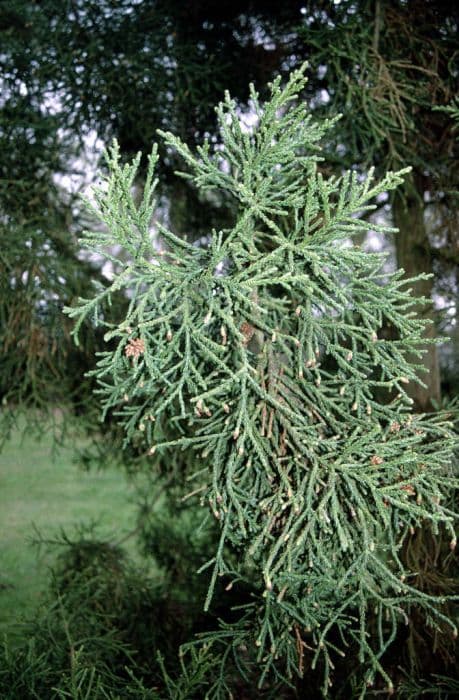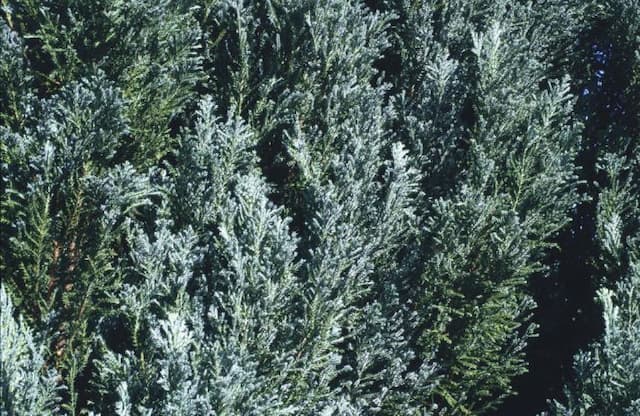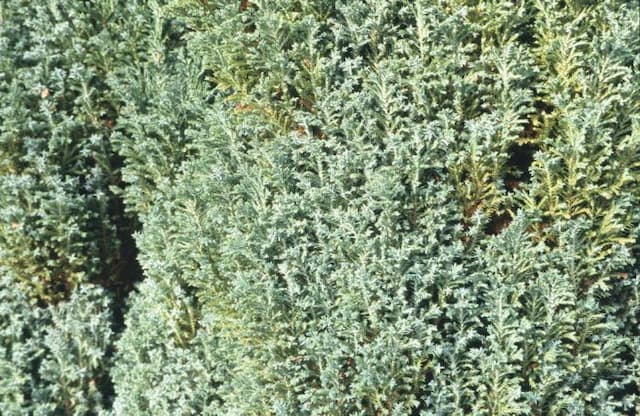Lawson Cypress Chamaecyparis lawsoniana 'Aurea Densa'











ABOUT
The Lawson cypress 'Aurea Densa' is an evergreen conifer characterized by its bright golden-yellow foliage. The leaves present in a striking scale-like formation, adorning the dense, compact branches of the plant. These leaves are arranged in flattened sprays, giving off a soft, feathery texture, which creates an eye-catching contrast against the darker greens typically found in a garden setting. The overall form of this cultivar tends to be conical, contributing to a neat and manicured appearance. As a slow-growing variety, the 'Aurea Densa' displays a consistent color throughout the year, maintaining its golden charm across seasons. When observed up close, the foliage may exhibit subtle hints of green, especially in the interior and shaded parts of the plant. The bright yellow coloring tends to be most pronounced on the foliage exposed to full sun, highlighting the plant's ornamental value. As the Lawson cypress 'Aurea Densa' matures, the bark takes on a fibrous texture, providing additional visual and tactile interest. While young stems remain smooth and somewhat hidden beneath the dense foliage, older branches reveal more of the rugged bark. The Lawson cypress 'Aurea Densa' produces small cones, but they are typically not a prominent feature of the plant. The cones are often hidden within the foliage and do not substantially contribute to the plant's ornamental appeal. Overall, the Lawson cypress 'Aurea Densa' is cherished for its vibrant yellow foliage and compact growth habit, which makes it an attractive choice for gardeners looking to add year-round color and structure to their landscape without concern for the plant's ultimate size or spread.
About this plant
 Names
NamesFamily
Cupressaceae.
Synonyms
Lawson's Cypress, Oregon Cedar, Port Orford Cedar, Yellow Cedar.
Common names
Cupressus lawsoniana 'Aurea Densa', Cupressus lawsoniana var. aurea 'Densa'.
 Toxicity
ToxicityTo humans
The plant commonly known as Lawson's Cypress is generally not considered highly toxic to humans. However, ingesting parts of the plant, particularly the foliage, can potentially cause mild stomach upset or irritation. It is advised to avoid consuming any part of this ornamental plant.
To pets
Lawson's Cypress is also not known for being highly toxic to pets. But, as with humans, ingestion can lead to mild gastrointestinal upset such as vomiting or diarrhea. If a pet consumes large amounts of the plant, monitoring for signs of distress and consulting with a veterinarian may be necessary. It's always best to prevent pets from chewing on or eating ornamental plants.
 Characteristics
CharacteristicsLife cycle
Perennials
Foliage type
Evergreen
Color of leaves
Gold
Height
6-8 feet (1.8-2.4 meters)
Spread
4-5 feet (1.2-1.5 meters)
Plant type
Tree
Hardiness zones
5
Native area
North America
Benefits
 General Benefits
General Benefits- Ornamental value: Chamaecyparis lawsoniana 'Aurea Densa', commonly known as Lawson's cypress, has attractive golden-yellow foliage that provides visual interest in gardens and landscaped areas.
- Privacy screening: Due to its dense growth habit, it can be used to create effective privacy screens and living fences.
- Windbreak: In addition to screening, it serves as a good windbreak, protecting other plants and reducing soil erosion.
- Noise reduction: With its thick foliage, Lawson's cypress can help to dampen traffic noise and other urban sounds when planted in groups.
- Habitat for wildlife: The tree can offer shelter and nesting sites for birds, as well as a habitat for certain beneficial insects.
- Low maintenance: Once established, it requires minimal care and is relatively drought-tolerant, making it an easy plant to grow for homeowners and landscapers.
- Soil stability: The root system helps in stabilizing the soil, which is particularly useful on slopes or areas prone to erosion.
 Medical Properties
Medical Properties- This plant is not used for medical purposes.
 Air-purifying Qualities
Air-purifying QualitiesThis plant is not specifically known for air purifying qualities.
 Other Uses
Other Uses- Woodworking: The wood of the Lawson's cypress is favored for its fine grain and workability, making it suitable for intricate woodworking projects such as model making or inlay work.
- Privacy screens: Due to its dense foliage, Lawson's cypress is commonly used to create living privacy screens in residential landscapes.
- Topiary and bonsai: The suitability of Lawson's cypress for pruning makes it an excellent choice for creating topiary art or for growing as a bonsai.
- Scented gardens: Lawson's cypress imparts a pleasant fragrance to the garden, which makes it a valuable addition to sensory gardens designed to be experienced through smell as well as sight.
- Soundscape features: When used in windbreaks, the dense foliage of the Lawson's cypress can help to reduce noise pollution by absorbing and diffusing sound.
- Therapeutic gardens: Its calming green-golden foliage can contribute to therapeutic garden spaces, offering a tranquil environment for relaxation and mental well-being.
- Educational uses: Lawson's cypress can be used in botany and horticulture education, illustrating characteristics of coniferous trees and landscaping principles.
- Erosion control: On slopes, Lawson's cypress can help to prevent erosion with its root system that stabilizes the soil.
- Habitat creation: By providing foliage for cover and cones for seeds, Lawson's cypress can support local wildlife in suburban areas.
- Cultural symbolism: In some cultures, conifers like Lawson's cypress are symbolic and may be planted in honor of certain traditions or beliefs.
Interesting Facts
 Feng Shui
Feng ShuiThe Lawson's Cypress is not used in Feng Shui practice.
 Zodiac Sign Compitability
Zodiac Sign CompitabilityThe Lawson's Cypress is not used in astrology practice.
 Plant Symbolism
Plant Symbolism- Longevity: Lawson Cypress 'Aurea Densa' belongs to the cypress family, which is often associated with immortality and eternal life due to the long lifespan of cypress trees.
- Protection: Historically, cypress trees have been planted in graveyards and are therefore symbolic of guarding and protection, with people believing they help to guide and protect the souls of the departed.
- Peace: The evergreen nature of Lawson Cypress 'Aurea Densa' can symbolize peace and tranquility, offering a sense of unchanging calm and solace throughout the year, regardless of other changes.
- Healing: Evergreens, including Lawson Cypress, have been thought to possess healing qualities, symbolizing health and recovery due in part to their refreshing scent and resins.
 Water
WaterThe Golden Lawson Cypress should be watered deeply and less frequently to encourage a strong root system. Typically, it requires watering once a week, but this can vary depending on the weather and soil drainage. During dry spells or hot weather, watering frequency should be increased, especially when the plant is young or newly planted. It's best to apply about 1 to 2 gallons of water per week for an established plant, ensuring that the soil is moist but not waterlogged. Overwatering or allowing the plant to sit in soggy soil can lead to root rot.
 Light
LightThe Golden Lawson Cypress thrives best in full sun to light shade. It should be planted in a location that receives at least four to six hours of direct sunlight each day. The ideal spot for this plant is one where it can bask in the morning sun and is protected from the intense afternoon heat if in an area with particularly hot summers.
 Temperature
TemperatureThe Golden Lawson Cypress does well in a variety of temperatures and is hardy in USDA zones 5 through 8. It can withstand minimum temperatures down to -20°F and maximum temperatures well above 100°F. However, the ideal temperature range for this plant is between 60°F and 75°F for optimal growth.
 Pruning
PruningPruning the Golden Lawson Cypress is typically done for shaping and to maintain its dense appearance. It should be pruned in the late winter or early spring before new growth starts. Thinning out crowded branches every few years helps to maintain airflow and plant health. Generally, light pruning is recommended, as heavy pruning can damage the plant.
 Cleaning
CleaningAs needed
 Soil
SoilThe best soil mix for the Golden Lawson Cypress should be well-draining, with a mix of peat, coarse sand, and loamy soil, and a slightly acidic to neutral pH value between 5.5 and 7.0.
 Repotting
RepottingGolden Lawson Cypress trees are slow-growing and do not require frequent repotting; they should be repotted every 3 to 5 years to refresh the soil.
 Humidity & Misting
Humidity & MistingThe Golden Lawson Cypress thrives in moderate humidity levels; outdoor conditions typically provide adequate humidity without the need for additional measures.
 Suitable locations
Suitable locationsIndoor
Ensure bright, indirect light and a cool room.
Outdoor
Plant in moist, well-drained soil, partial to full sun.
Hardiness zone
5-8 USDA
 Life cycle
Life cycleThe common name for Chamaecyparis lawsoniana 'Aurea Densa' is Lawson's Cypress 'Aurea Densa'. The life cycle begins with seed germination, where the seeds require a period of cold stratification to break dormancy. Seedlings emerge and go through a juvenile phase, developing a root system and foliage. As the plant matures, it enters the vegetative stage, characterized by significant growth in height and diameter, and the dense, yellow-green foliage forms its characteristic shape. Reproductive maturity is reached after several years, with the formation of cones which, upon pollination by wind, produce seeds, completing the cycle. The life span of Lawson's Cypress 'Aurea Densa' can extend for many decades, during which it may go through cycles of growth, cone production, and eventual senescence.
 Propogation
PropogationPropogation time
Late winter to early spring
Propogation: The most popular method of propagating the Lawson's Cypress 'Aurea Densa' is through semi-hardwood cuttings. This is ideally done in late summer to early autumn, when the current year's growth has begun to harden. Cuttings of about 4 to 6 inches (10 to 15 centimeters) are taken from healthy branches, making sure to include several sets of needles. The cut end is dipped in rooting hormone to encourage root development and then inserted into a well-draining soil mix. The soil should be kept moist but not overly wet to prevent rot. The cuttings are then placed in a bright, indirect light setting and covered with a plastic bag or dome to maintain humidity until roots have developed, which can take several weeks to a few months.









